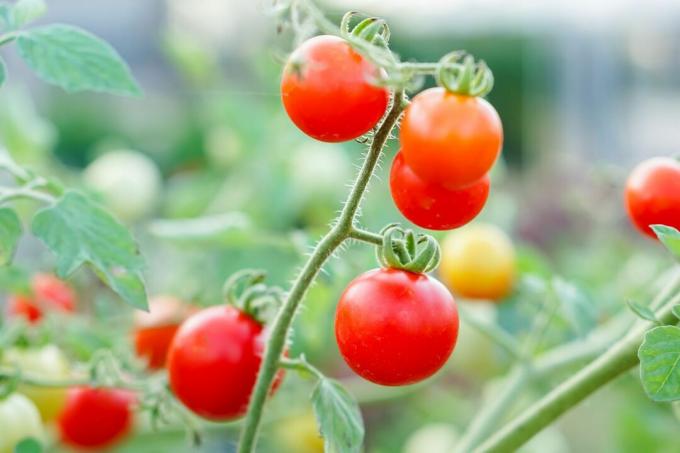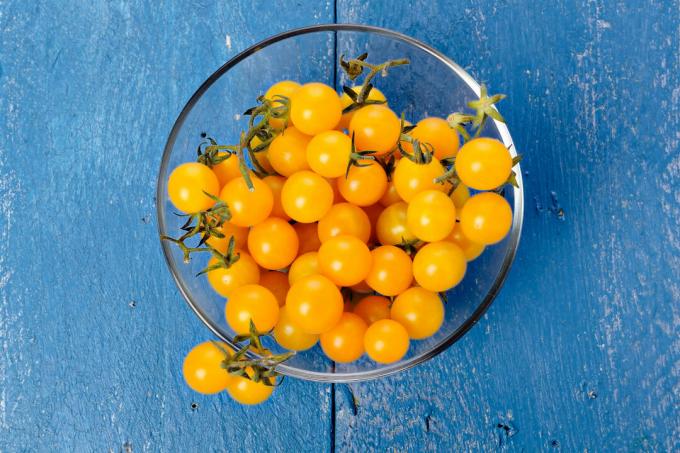How do currant tomatoes taste? What do you have to consider when planting and caring for? Are there also yellow currant tomatoes? Here you can find out everything you need to know about the special tomato variety.

The tiny currant tomatoes have been a favorite in home gardens and on balconies for years. We introduce you to the early and high-yielding tomato variety.
contents
- Currant tomato: profile
- Origin and history
- Properties and taste of the currant tomato
-
The best varieties of currant tomatoes
- Red currant tomatoes
- Yellow currant tomatoes
- Plant and care for currant tomatoes
- Harvest and use currant tomatoes
Currant tomato: profile
| fruit | Cocktail tomato; red or yellow |
| taste | sweet-sour, spicy |
| Ripening time | early |
| growth | Wild tomato, up to 150 cm |
| Location | Greenhouse, open field, pot |
Origin and history
The currant tomato (Lycopersicon pimpinellifolium) comes directly from the wild tomatoes in Peru and Ecuador and is only distant with our cultivated tomato (
Lycopersicon esculentum) related. They were bred for taste rather than larger fruit like all of our other varieties. However, some varieties have hardly been changed in terms of breeding. Wild tomatoes are characterized by their numerous, very small fruits and their branched, bushy growth. This also applies to the currant tomatoes.Properties and taste of the currant tomato
Currant tomatoes can be found under the yellow tomato varieties, but the best known are the red varieties. Currant tomatoes grow strongly in width, they reach a height of about 1.5 meters and a width of one meter. The plants have delicately pinnate leaves and produce countless small, round tomatoes from mid-July. The fruits reach a maximum diameter of one centimeter and form many seeds inside. The taste of the currant tomato can be described as sweet and sour and spicy to tomato.
The currant tomatoes are seed-proof; seeds can be obtained from the fruits for growing in the next year. The wild tomato also grows wild in the garden. If, for example, fruit has landed on the compost, many small plants often open up in the following spring. In this way, the currant tomato can be easily propagated without much effort.

The best varieties of currant tomatoes
There are also different varieties of the tiny currant tomatoes. We introduce you to the best yellow and red varieties.
Red currant tomatoes
The red currant tomato, also called ‘Red Currant’, is the classic of the tiny tomatoes. The fruits weigh around three grams and ripen very early on the compact plants. An even smaller variety of currant tomatoes is the tiny, tasty tomato ‘Spoon’ (English for "spoon"). The pea-sized, deep red fruits fit several on a spoon, hence the name. The juicy mini tomatoes have an almost burst-resistant skin and can become very large as plants.
Yellow currant tomatoes
The 'Golden currant‘Grows as lush as the red varieties and delights with lots of sun-yellow, sweet fruits from mid-July. It is uncomplicated and easy to care for, but it needs space across the board. The ‘Gold Rush‘ variety is primarily characterized by its long panicles with countless small orange-yellow fruits. It ripens well in autumn on the warm windowsill.
All of the varieties mentioned are hardly susceptible to diseases such as Late blight and are therefore also suitable for outdoor cultivation.

Plant and care for currant tomatoes
Currant tomatoes are very adaptable in terms of location and can be grown in the greenhouse, on the balcony or outdoors. The compact growth of the currant tomatoes makes them ideal for keeping in pots or in hanging baskets. The wild tomato is extremely vigorous and does not have to be exhausted. It is best to simply let it grow, because it also bears fruit on all side shoots. With hanging baskets and pots, the choice of soil is crucial to keep the plants healthy and productive. When planting, fill the planters with a special tomato soil from mid-May - like our Plantura Organic tomato soil - and put the young plants deep inside. The nutrients it contains give the currant tomatoes a good start to summer and encourage flowering.
In hanging baskets and pots, the plants quickly take up a lot of space and quickly begin to fruit. From this point on, the currant tomatoes need additional nutrients to feed the many fruits. Our Plantura Organic liquid tomato fertilizer can be easily fertilized with the irrigation water every one to two weeks.
Harvest and use currant tomatoes
The many tiny fruits of the currant tomatoes are ideal for fresh consumption directly from the plant. As a whole in salads they are a pretty eye-catcher and a real taste experience. With the mass of fruits, it is also worthwhile to dry them to preserve them. To do this, cut the small fruits in half and dry them in the oven over low heat. So the tasty tomatoes can still be enjoyed in winter.
Would you like to grow the currant tomatoes or other tasty varieties on your balcony? We'll provide tips and tricks just like you Grow tomatoes on the balcony and be able to reap abundant fruits.
